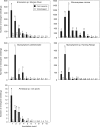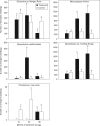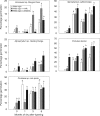Seed dormancy and persistent sediment seed banks of ephemeral freshwater rock pools in the Australian monsoon tropics
- PMID: 25660345
- PMCID: PMC4373295
- DOI: 10.1093/aob/mcv014
Seed dormancy and persistent sediment seed banks of ephemeral freshwater rock pools in the Australian monsoon tropics
Abstract
Background and aims: Rock pools are small, geologically stable freshwater ecosystems that are both hydrologically and biologically isolated. They harbour high levels of plant endemism and experience environmental unpredictability driven by the presence of water over variable temporal scales. This study examined the hypothesis that the sediment seed bank in monsoon tropical freshwater rock pools would persist through one or more periods of desiccation, with seed dormancy regulating germination timing in response to rock pool inundation and drying events.
Methods: Seeds were collected from seven dominant rock pool species, and germination biology and seed dormancy were assessed under laboratory conditions in response to light, temperature and germination stimulators (gibberellic acid, karrikinolide and ethylene). Field surveys of seedling emergence from freshwater rock pools in the Kimberley region of Western Australia were undertaken, and sediment samples were collected from 41 vegetated rock pools. Seedling emergence and seed bank persistence in response to multiple wetting and drying cycles were determined.
Key results: The sediment seed bank of individual rock pools was large (13 824 ± 307 to 218 320 ± 42 412 seeds m(-2) for the five species investigated) and spatially variable. Seedling density for these same species in the field ranged from 13 696 to 87 232 seedlings m(-2). Seeds of rock pool taxa were physiologically dormant, with germination promoted by after-ripening and exposure to ethylene or karrikinolide. Patterns of seedling emergence varied between species and were finely tuned to seasonal temperature and moisture conditions, with the proportions of emergent seedlings differing between species through multiple inundation events. A viable seed bank persisted after ten consecutive laboratory inundation events, and seeds retained viability in dry sediments for at least 3 years.
Conclusions: The persistent seed bank in freshwater rock pools is likely to provide resilience to plant communities against environmental stochasticity. Since rock pool communities are often comprised of highly specialized endemic and range-restricted species, sediment seed banks may represent significant drivers of species persistence and diversification in these ecosystems.
Keywords: Ephemeral freshwater wetland; ethylene; hydrophytes; sandstone rock pools; sediment seed bank; seed dormancy; seed germination; seedling emergence patterns.
© The Author 2015. Published by Oxford University Press on behalf of the Annals of Botany Company. All rights reserved. For Permissions, please email: journals.permissions@oup.com.
Figures





Similar articles
-
Dormancy cycles in buried seeds of three perennial Xyris (Xyridaceae) species from the Brazilian campo rupestre.Plant Biol (Stuttg). 2017 Sep;19(5):818-823. doi: 10.1111/plb.12597. Epub 2017 Jul 25. Plant Biol (Stuttg). 2017. PMID: 28646622
-
Seeds of Brassicaceae weeds have an inherent or inducible response to the germination stimulant karrikinolide.Ann Bot. 2011 Oct;108(5):933-44. doi: 10.1093/aob/mcr198. Epub 2011 Aug 5. Ann Bot. 2011. PMID: 21821831 Free PMC article.
-
Ecological longevity of Polaskia chende (Cactaceae) seeds in the soil seed bank, seedling emergence and survival.Plant Biol (Stuttg). 2017 Nov;19(6):973-982. doi: 10.1111/plb.12611. Epub 2017 Sep 11. Plant Biol (Stuttg). 2017. PMID: 28787550
-
Dormancy and germination: How does the crop seed decide?Plant Biol (Stuttg). 2015 Nov;17(6):1104-12. doi: 10.1111/plb.12356. Epub 2015 Jul 14. Plant Biol (Stuttg). 2015. PMID: 26095078 Review.
-
[Adaptation strategies of seed germination and seedling growth to sand dune environment].Ying Yong Sheng Tai Xue Bao. 2006 Jan;17(1):137-42. Ying Yong Sheng Tai Xue Bao. 2006. PMID: 16689250 Review. Chinese.
Cited by
-
Terrestrial Morphotypes of Aquatic Plants Display Improved Seed Germination to Deal with Dry or Low-Rainfall Periods.Plants (Basel). 2021 Apr 10;10(4):741. doi: 10.3390/plants10040741. Plants (Basel). 2021. PMID: 33920068 Free PMC article.
-
Hydrological and thermal responses of seeds from four co-occurring tree species from southwest Western Australia.Conserv Physiol. 2020 Apr 30;8(1):coaa021. doi: 10.1093/conphys/coaa021. eCollection 2020. Conserv Physiol. 2020. PMID: 32377342 Free PMC article.
-
Defining the role of fire in alleviating seed dormancy in a rare Mediterranean endemic subshrub.AoB Plants. 2017 Jul 29;9(5):plx036. doi: 10.1093/aobpla/plx036. eCollection 2017 Sep. AoB Plants. 2017. PMID: 28948008 Free PMC article.
-
Morphophysiological dormancy in the basal angiosperm order Nymphaeales.Ann Bot. 2019 Jan 1;123(1):95-106. doi: 10.1093/aob/mcy142. Ann Bot. 2019. PMID: 30052753 Free PMC article.
-
Germination physiology of Cochlospermum fraseri (Bixaceae), a deciduous tree from Northern Australia with physical seed dormancy.Conserv Physiol. 2023 Sep 1;11(1):coad057. doi: 10.1093/conphys/coad057. eCollection 2023. Conserv Physiol. 2023. PMID: 37671236 Free PMC article.
References
-
- Alvarez M, San Martin J, Deil U. 2012. Nanism and ephemerism as reasons for a hidden abundance in vernal pool plants: the example of Lepuropetalon spathulatum in Chile. Feddes Repertorium 123: 55–66.
-
- Aponte C, Kazakis G, Ghosn D, Papanastasis VP. 2010. Characteristics of the soil seed bank in Mediterranean temporary ponds and its role in ecosystem dynamics. Wetlands Ecology and Management 18: 243–253.
-
- Baskin CC, Baskin JM, Chester EW. 1993. Seed germination ecophysiology of four summer annual mudflat species of Cyperaceae. Aquatic Botany 45: 41–52.
-
- Baskin CC, Baskin JM. 2014. Seeds. Ecology, biogeography, and evolution of dormancy and germination, 2nd edn San Diego: Academic Press.
Publication types
MeSH terms
Substances
LinkOut - more resources
Full Text Sources
Other Literature Sources

